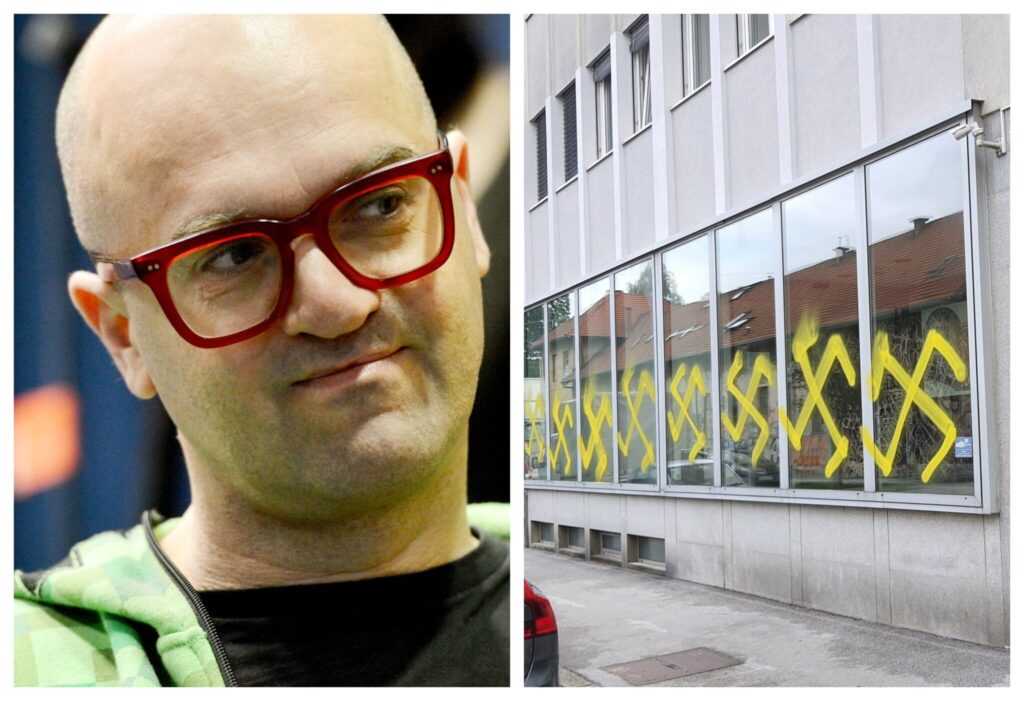A couple of weeks ago, we wrote about the vandals drawing graffiti on the façade of the building of the Ministry of Culture. Surveillance camera footage revealed that several men with hoodies painted yellow swastikas on the outside of the building and then fled. We learned from reliable sources that one of the people who drew the swastikas on the Ministry of Culture was also the activist and digital strategist of the SD party, Vuk Čosić, who has also been spotted at the anti-government protests several times before. It will be interesting to see how the president of the Social Democrats (SD), Tanja Fajon, who condemned the vandalism at the Ministry of Culture, comments on Čosić’s involvement.
Surveillance camera footage revealed that a group of men came to the Ministry, headed by Minister Vasko Simoniti, from Metelkova, and it can also be seen from the footage that they returned there too. Given that it seems that the digital strategist of the SD party, Vuk Čosić, was also among the vandals who painted the swastikas, many people have come to the conclusion that the SD party obviously supports the violence that is taking place in the streets of Ljubljana!
Čosić presents himself to the public as a genius and an expert in the field of digital technologies in Slovenia. But his reasons for getting to where he is may also be hiding elsewhere. In the past, he was a co-founder or director of companies that received good amounts of money from the state budget. The companies where he worked or was also a co-owner have received at least 3 million euros from the state budget. Čosić is another radical left-wing activist who has earned excellent money at the expense of Slovenian taxpayers in recent years.
A little while ago, he was also the guest on the national radio, where he bashed the government
The radio station Val 202 described Čosić as a “digital player, online interactive artist, pioneer of internet art, communication expert, civil society activist, protester and protest strategist.” As they are both characterised by a long period of dissident behaviour and rebellion, he happily compared the protests from the years 2012 to 2014 to the Friday protest movement we are witnessing now in his recent interview. “We can find lots of similarities, the actors on both sides of the barricade are similar, but there are also many differences. The question arises as to how much emotion and how much politics is involved here, how much tactical action is present, working towards the result, which can then be seen in parliamentary politics. In both cases, there is a tremendous amount of emotion and very little politics. The topic is political; however, the actions are not political,” he stated.
Among other things, Čosić also said that since the latest protests have been going on for a year and a half now, communication between groups is difficult. “People who are not at peace with the feeling of revolt are willing to invest a lot of energy. It is the main fuel. We need knowledge, skills, people from the theatre are also involved, we need people who know how to organise events, we have small groups that stick to their goals, and the beauty of this situation is that there is a need for everyone to work together,” he also said.
At the anti-government protests, we have already witnessed several vulgar acts, including death threats being made against Prime Minister Janez Janša and his supporters, but the opposition has still not condemned any of these actions. However, since even the competent institutions decided not to react, we have now found ourselves in this situation, where vandalism seems to have no limit or end in sight. The recent vile actions justifiably shook Slovenia up, as swastikas were painted on the façade of the Ministry. Among others, the president of the SD party, Tanja Fajon, also condemned the vandalism, writing the following on her Twitter profile: “I condemn the vandalism at the Ministry building, as well as any other expression of hatred and intolerance. I hope the perpetrators are caught soon. Because Slovenia cannot become a place where everything is allowed.” Given that the party’s digital strategist is allegedly involved, it seems that the SD party is not condemning vandalism after all, at least not to the extent that it may seem, judging by the reaction of the president. This is why we decided to send a journalistic question to the SD party headquarters to ask them about it. When we receive an answer, we will publish it here.
Sara Kovač


